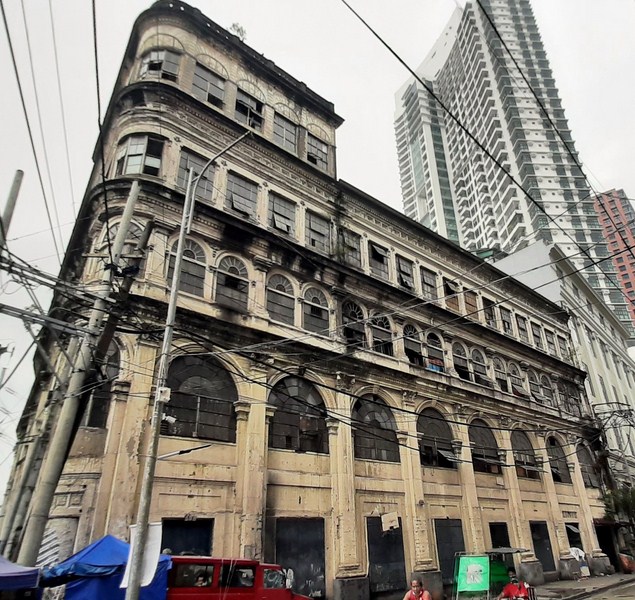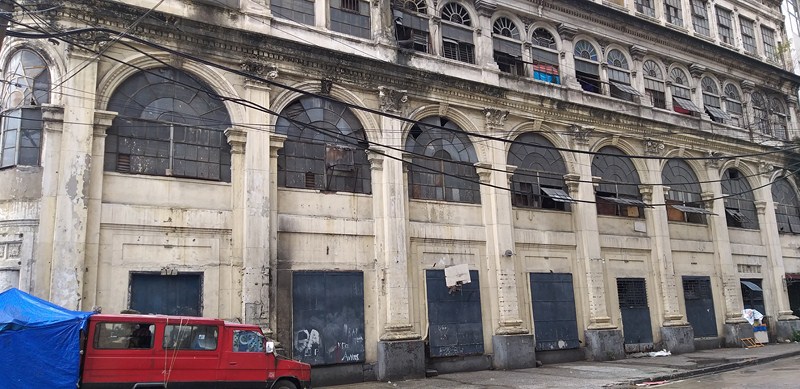The El Hogar Filipino Building (Spanish: Edificio El Hogar Filipino), also known simply as El Hogar, was an early skyscraper in the Philippines. Built sometime between 1911 and 1914, it was designed by Spanish-Filipino engineer Don Ramón José de Irureta-Goyena Rodríguez and architect Francisco Perez-Muñoz in the Beaux-Arts style, its architecture reflecting elements of Neoclassical and Renaissance styles. Opened on December 2014, it was one of the first buildings in Manila built entirely out of concrete.
Right across Juan Luna Street, on its northern front, is Pacific Commercial Company Building (commonly known as the First National City Bank Building, it was built in 1922), another important edifice, and the Hong Kong and Shanghai Bank Building on its rear.
Check out “Pacific Commercial Company Building” and “Old HSBC Building”
The four-storey building, by the Pasig River, was built as a wedding present of Don Antonio Melian y Pavia, a Spanish businessman who was titled as the third Conde de Peracamps, to his bride Doña Margarita Zóbel y de Ayala, who was a sister of patriarch Don Enrique Zóbel de Ayala.
Don Antonio was born on May 21, 1879 in Las Palmas in the Canary Islands in Spain. From Spain, he sailed to Peru in 1903 where he held posts in the insurance company La Previsora and in the Casino Español de Lima. In 1907, he first set foot in Manila and, on June that same year, married Don Enrique Zóbel de Ayala‘s sister Doña Margarita Zóbel y de Ayala at San Agustin Church. In 1910, he sailed from Peru back to the Philippines and established the El Hogar Filipino and the Filipinas Compañía de Seguros together with his brothers-in-law Enrique and Fernando Zóbel y de Ayala.
The El Hogar housed the Melián business empire, such as the Filipinas Compañía de Seguros (the first local-owned fire insurance company), Tondo de Beneficiencia, Casa de España, Casa de Pensiones, and Sociedad El Hogar Filipino, a financing cooperative and lending company. Other tenants of the El Hogar include Ayala y Compañía, Sociedad Lizárraga Hermanos, and Smith, Bell and Company (a shipping company). In the 1920s, after the completion of its own building at the foot of the Jones Bridge in Plaza Moraga, a short walk from the El Hogar, the Filipinas Compañía de Seguros moved out of the El Hogar.
Check out “The Revitalized Jones Bridge”
It survived World War II (it only suffered minor damages during the Battle of Manila in 1945) and a number of earthquakes and is one of two remaining American-era structures in the area facing the Pasig River. In the post-war years, Sociedad El Hogar Filipino closed down, along with other Melián businesses, leaving only the Filipinas Compañía de Seguros. Because of this, the Meliáns sold the El Hogar to the Fernandez family, and the El Hogar was rented out to other companies, mostly customs brokerage firms with few residential tenants. It also became the shooting location of movies, TV shows and fashion and advertising shoots. Some decades ago, the building was finally abandoned as an office building and fell into neglect and decay.
On February 2014, news involving the El Hogar sparked when it was reported that it was sold to The Ritz Premiere Corporation, a Chinese-Filipino real estate developers, which reported that it will demolish the El Hogar because of the building’s stability, and be turned into a condominium. By November, G.I. sheets fenced up the El Hogar Building, seemingly being prepared for demolition.
The news spread like a wildfire throughout heritage conservationists (who wrote to both the city government of Manila and the National Historical Commission of the Philippines, or NHCP, to stop the demolition of the El Hogar), cultural advocates, and ordinary citizens alike. Because of this, a petition to stop the demolition was created. The Ritz Premiere Corporation said that they do not have plans of demolishing the El Hogar but will, instead, use it as a warehouse. The NHCP issued a cease and desist order and attempted to purchase the iconic building. However, negotiations were halted when NHCP and The Ritz could not agree with the price. The building’s status is still uncertain.
Some of the building’s interesting features are its two garden courtyards and its unique mirador (balcony) where one can see the Pasig River and the southern part of Manila which includes the walled city of Intramuros, Ermita, and Malate. El Hogar’s magnificently ornate grand staircase, considered as one of the most ornate in the city, has a sculpted mythical griffin as its base and bears Antonio’s and Margarita’s initials. However, on July 6, 2014, the magnificent and intricate grille work of the building’s grand staircase were seen being loaded to a truck belonging to a building contractor.
The value of the El Hogar Filipino Building is its architecture. A representation of American period design, materials and construction methods, the building is a representation of the architecture of business establishments of that era. It also has a collective value as one of the significant structures within the historic Binondo district and Escolta Street, along the cultural landscape of the Pasig River.
El Hogar Filipino Building: cor. Juan Luna St. and Calle Muelle dela Industría, Binondo, Manila.



Pingback: References – historical structures in the philippines